Physical Address
304 North Cardinal St.
Dorchester Center, MA 02124
Acknowledgments: The author gratefully acknowledges the outstanding previous chapters on these topics in prior editions of Green’s Operative Hand Surgery, written by James R. Doyle, Richard I. Burton, Julie A. Melchior, Mark E. Baratz, Christopher C. Schmidt, and Thomas B. Hughes.
In contrast to zone 2 flexor tendon injuries, most extensor tendon repairs are liberated from the confines of a fibroosseous tunnel. Conversely, standard core flexor tendon sutures become technically impossible when dealing with the thin, flat extensor mechanism over the phalanges. These are just some of the differences between injuries of the flexor and extensor tendons. This chapter reviews issues concerning the evaluation and treatment of acute and chronic extensor tendon injuries.
As in most areas of the hand, an understanding of extensor tendon anatomy is crucial to analyzing and treating injuries to this system.
The extensor tendons originate from the finger extensor muscle bellies of the extensor digitorum communis (EDC), extensor indicis proprius (EIP), extensor pollicis longus (EPL), extensor digiti minimi (EDM), abductor pollicis longus (APL), and extensor pollicis brevis (EPB); the radial wrist extensor muscle bellies of the extensor carpi radialis longus and brevis (ECRL and ECRB); and the extensor carpi ulnaris (ECU). All of these muscles are innervated by branches from either the radial nerve or the posterior interosseous nerve.
The most common anatomic variations are accessory muscles and tendons associated with the wrist extensors. The extensor carpi radialis intermedius, reported to be found in 12% of limbs, may arise superficial and radial to or between the ECRL and ECRB. The significance of this accessory muscle is that it may be harvested for use as a tendon transfer in paralytic disorders when donor muscles are lacking. Anomalous tendons originating from the radial wrist extensors have been described inserting on the index or middle metacarpal base. These accessory tendons and interconnections may need to be released during tendon transfer procedures to achieve full excursion.
The extensor medii proprius can be considered to be an EIP of the middle finger, found in 10% of hands, and has been used in reconstruction of chronic sagittal band injuries. The insertion is typically ulnar to the EDC insertion on the middle finger, as is the usual arrangement of the EIP with respect to the EDC index tendon and the EDM with respect to the small finger EDC tendon. The extensor indicis et medii communis is a variation of the EIP that inserts into the middle and index fingers.
The extensor digitorum brevis manus muscle (EDBM) is an anomalous muscle on the dorsum of the hand, found in 3% of hands, usually arising between the index and middle finger metacarpals and inserting on the extensor hood of the index or middle fingers with or without anomalies of the EIP. Ogura and associates described five types of EDBMs, depending on the insertion and relationship to the EIP. The clinical significance of the EDBM is that it can be mistaken for a dorsal wrist ganglion cyst; it becomes firm when the wrist is slightly flexed and the fingers are extended. It may also be a source of dorsal wrist pain and can be completely excised if needed ( Fig. 5.1 ).
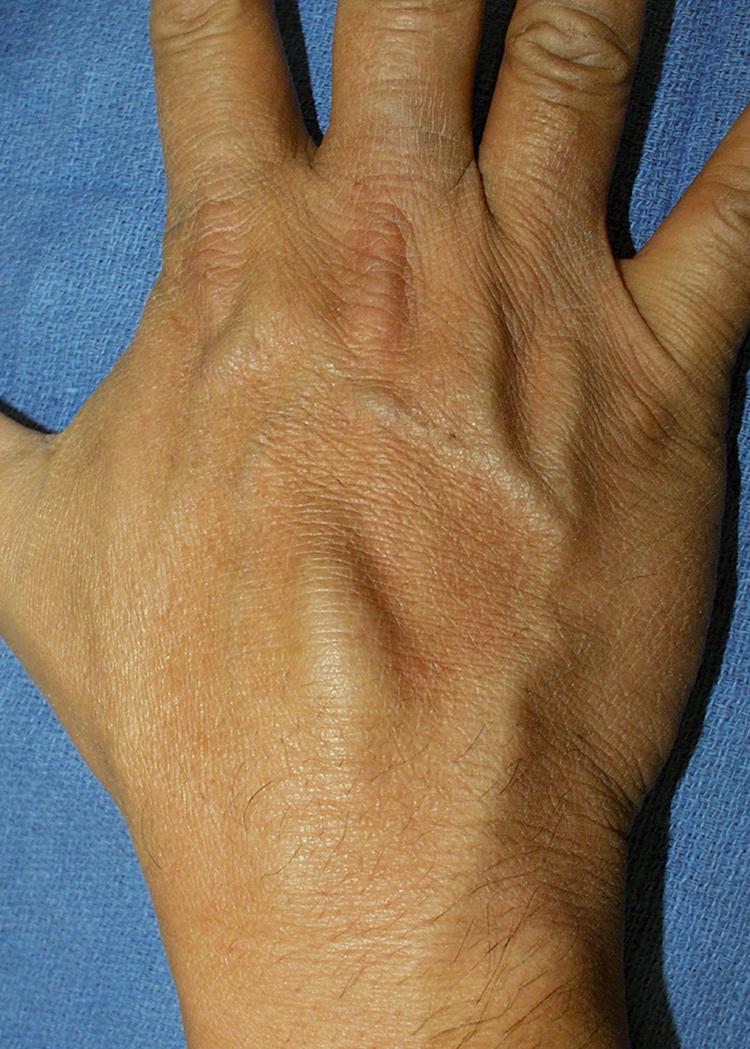
The musculotendinous junction is usually approximately 4 cm proximal to the wrist joint, although muscle fibers of the EIP often continue to the wrist joint level. At the level of the wrist, the tendons course through six individual, synovial-lined, fibroosseous sheaths known as the six extensor tendon compartments ( Fig. 5.2A ). The fifth extensor compartment is technically a fibrous tunnel only because it does not insert on bone. The sixth extensor tendon compartment, containing the ECU tendon, has a subsheath that maintains the relationship of the tendon to the underlying ulna, and rupture or injury of this subsheath may result in symptomatic ECU tendon subluxation. The proximity of the extensor tendons to the radius puts them at risk from protruding dorsally directed screws from a volar locking plate in the treatment of distal radius fractures ( Fig. 5.3 and ![]() ). ( Case Study 5.1 ; also see Chapter 15 , Distal Radius Fractures.)
). ( Case Study 5.1 ; also see Chapter 15 , Distal Radius Fractures.)
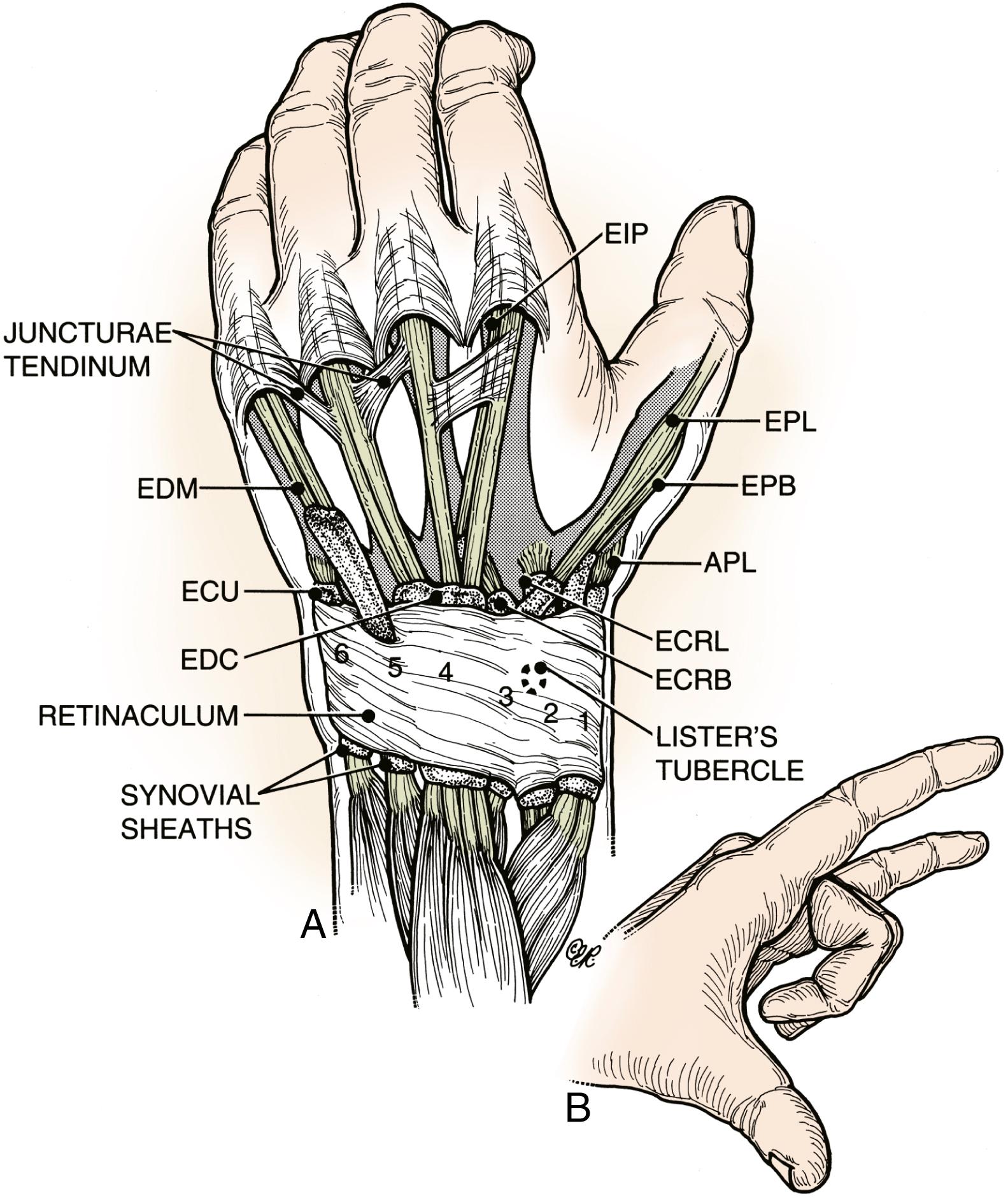
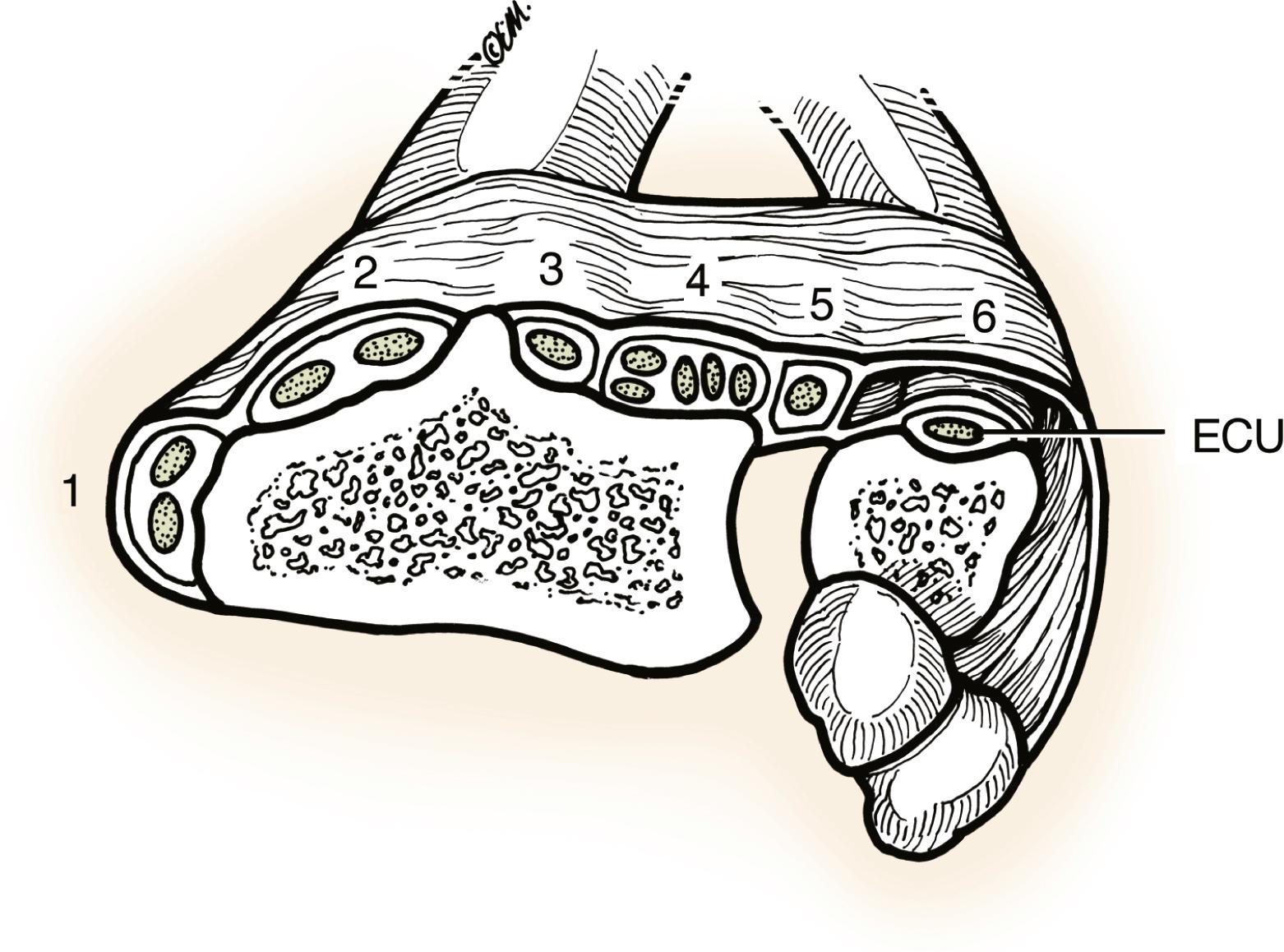
A 45-year-old man with ulnar-sided wrist pain notices a clicking sensation on the ulnar side of the wrist, which developed after he played tennis. (See ![]() .)
.)
What is the diagnosis?
ANS: ECU instability
Which structure has been injured to allow ECU subluxation to occur?
ANS: ECU subsheath
In the acute situation, how should the forearm and wrist be immobilized for nonoperative treatment?
ANS: Remember that the ECU subluxates with supination, wrist flexion, and ulnar deviation. Therefore the position of pronation, wrist extension, and radial deviation is most likely to relocate the tendon.
Proximal to the metacarpophalangeal (MP) joint level, stout interconnecting bands exist between the ring EDC and the small and middle fingers, and there is a less substantial band from the EDC of the middle to the EDC of the index finger. The importance of these juncturae tendinum is that finger extension can be preserved if the EDC is lacerated proximal to a junctura tendinum that connects that finger to an intact extensor tendon. The juncturae tendinum also restrict independent extension of the ring and middle fingers when the other digits are flexed at the MP joints. Varying morphologies of juncturae tendinum have been described by Hirai and colleagues (see Fig. 5.2 ).
The EIP and EDM allow independent extension of the index and small fingers, although loss of the EIP because of tendon transfer or injury does not eliminate the ability to extend the index finger independently at the MP joint. This is true as long as the extensor hood at the index MP joint level is not injured. Isolated loss of the EDM can lead to loss of independent extension of the small finger because the anatomic structure of the EDC to the small finger is highly variable. EDC of the small finger may be absent and replaced exclusively by a junctura tendinum from the ring finger (see Fig. 5.2 ).
The typical arrangement of finger extensor tendons is as follows: (1) single EIP inserting ulnar to the EDC tendon of the index finger; (2) single tendon from the EDC to the index and middle fingers; (3) double tendon from the EDC to the ring finger; (4) absent EDC to the small finger but usually a substantial junctura tendinum from the ring EDC to the EDM; and (5) double EDM tendon to the little finger with a double insertion into the MP joint hood (see Fig. 5.2 ). Variations of extensor tendons have been noted, including a double slip of the EIP; an EIP inserting volar or radial to the EDC; and, rarely, absence of the EDC and junctura tendinum to the small finger, in which case harvesting the EDM would lead to small finger MP joint extensor lag.
The extensor tendon at the MP joint level is maintained in a central position by the sagittal bands, which arise from the volar plate of the MP joint and the intermetacarpal ligaments, to insert on the extensor hood. Injury to the sagittal bands may result in subluxation of the EDC.
The mechanism by which extension of the MP joint is achieved by the pull of EDC tendons is not related to a direct insertion of the tendon on the base of the proximal phalanx. Van Sint Jan and colleagues showed that although there is a “central slip” on the base of the middle phalanx, there is no such structure on the base of the proximal phalanx. Instead, there is loose connective tissue between the EDC and the base of the proximal phalanx. Extension of the MP joint is transmitted by the pull of the EDC tendon through the sagittal bands ( Fig. 5.4 ). When the sagittal band system is damaged, and the EDC tendon subluxates or dislocates off the central axis of the finger, MP joint extension is compromised.
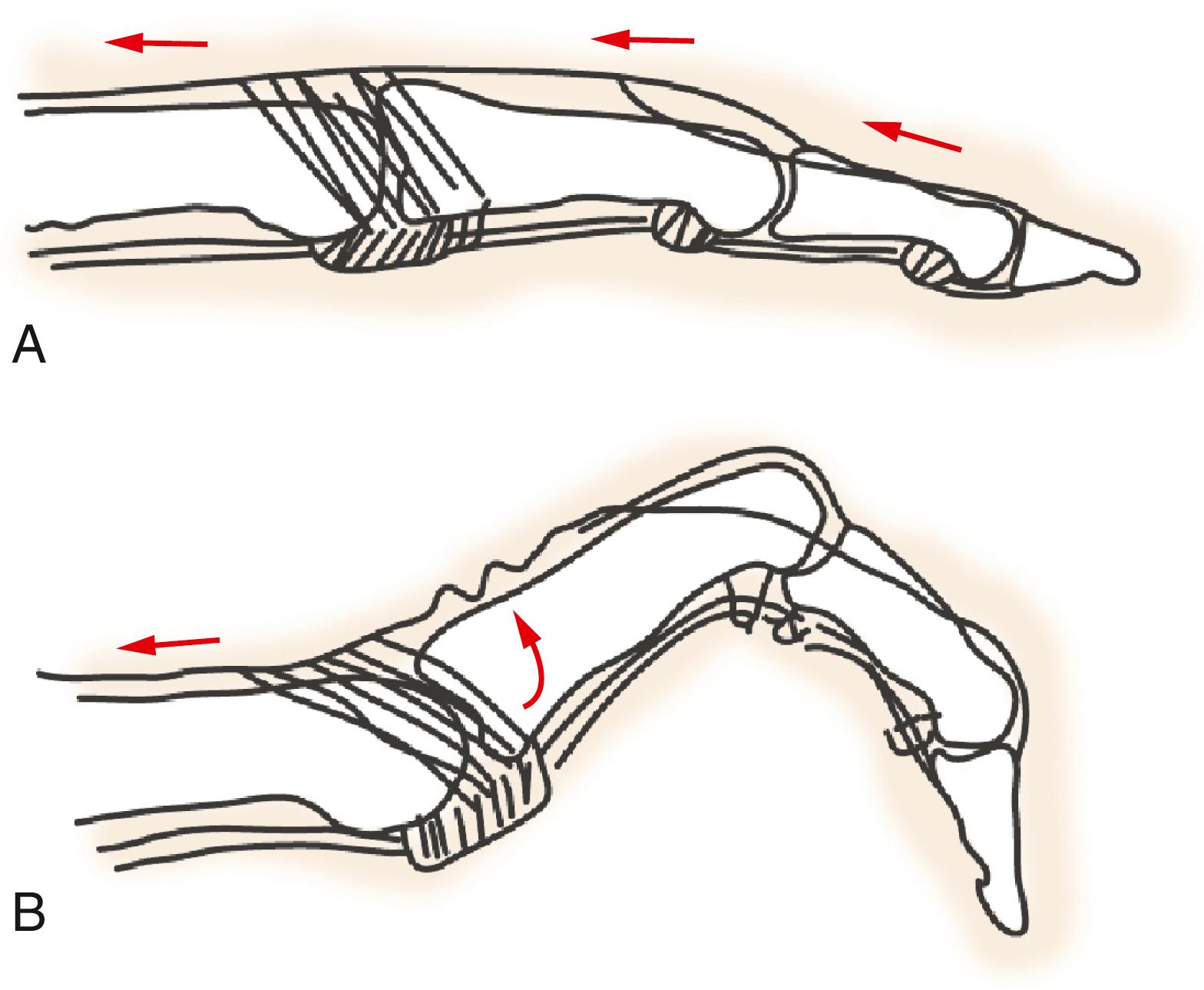
The anatomy of the extensor mechanism is an intricate and layered system that changes geometry as the finger flexes and extends, allowing the lateral bands to displace volarly in flexion and return to the dorsum of the finger in extension. The intrinsic tendons from the lumbricals and interossei form the lateral bands, which join the extensor mechanism at the proximal third of the proximal phalanx. The lumbrical muscle functions both to flex the MP joint and to extend the IP joints owing to its insertion on the lateral band. The lumbrical also contracts during IP and MP extension, and in doing so, “relaxes” the profundus tendon by pulling it distally through the lumbrical flexor digitorum profundus (FDP) origin in the palm. The EDC trifurcates proximal to the proximal interphalangeal (PIP) joint, with the central component becoming the central slip and the lateral components joining up with the lateral bands. These conjoined lateral bands coalesce over the middle phalanx and continue distally to become the terminal tendon ( Fig. 5.5 ).
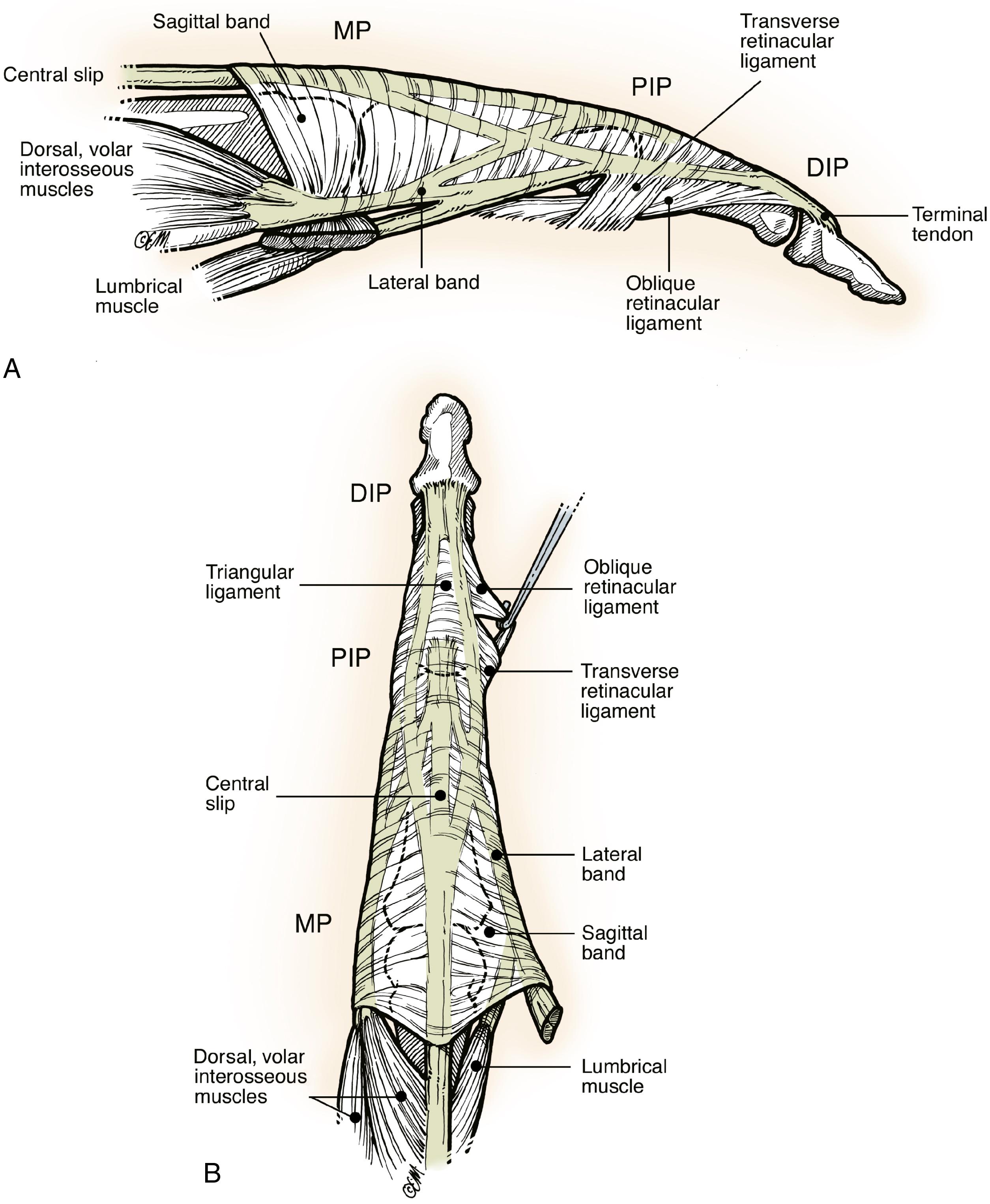
The lateral bands are maintained in position by the triangular ligament, which unites them dorsal and distal to the PIP joint, and the transverse retinacular ligaments, which stabilize them to the flexor tendon sheath. The primary function of the triangular ligament is to prevent palmar subluxation of the lateral bands during PIP joint flexion, which can occur in the boutonnière deformity as a result of triangular ligament incompetence. The primary function of the transverse retinacular ligament is to prevent dorsal subluxation of the lateral bands during extension, as can occur in a swan neck deformity. There is a normal dorsal-palmar translation of the lateral bands with respect to the PIP joint axis of rotation during flexion and extension, which must be preserved to retain normal extensor function. The central slip insertion on the base of the middle phalanx helps to initiate extension of the PIP joint; however, PIP joint extension is possible even in the absence of the central slip, provided that the triangular ligament, lateral bands, and transverse retinacular ligaments are functioning normally ( Figs. 5.6 and 5.7 ). Distal to the triangular ligament, the lateral bands converge to form the terminal tendon, which inserts onto the base of the distal phalanx. The germinal nail matrix, which creates the nail plate, arises approximately 1.2 mm distal to the terminal tendon insertion.
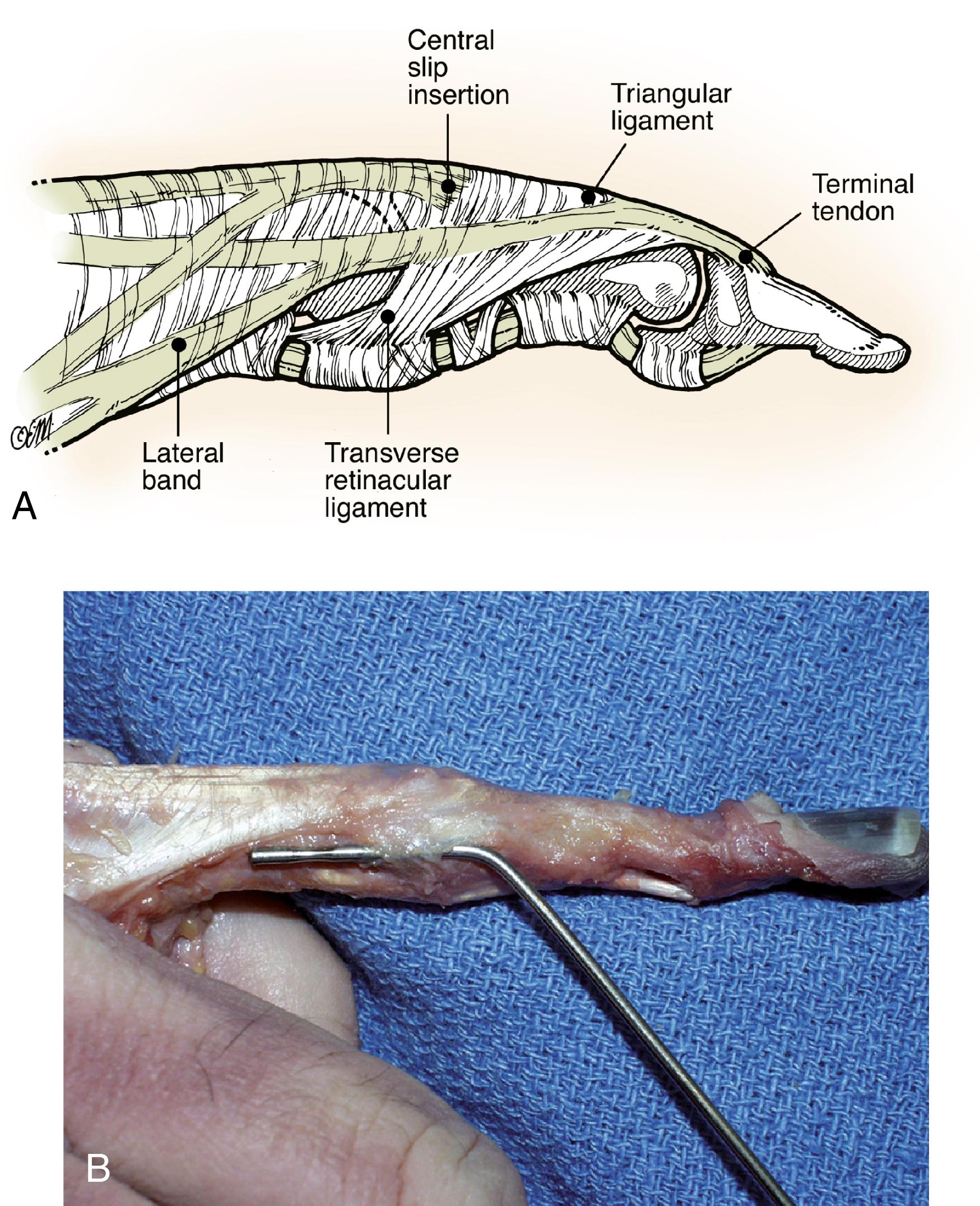

Extension of the fingers at the MP joint is exclusively a function of the extrinsic extensor tendons. Extension of the PIP joints, although primarily a function of the intrinsic interossei and lumbrical muscles, can also occur through the extrinsic tendon extensor system, provided that MP joint hyperextension is blocked. When intrinsic palsy allows the MP joint to hyperextend, the extrinsic extensor system becomes insufficient to extend the interphalangeal (IP) joints, and a “claw finger” results. This deformity occurs because of “slack” in the extensor mechanism distal to the sagittal bands and the increased flexor tone in this position (see Fig. 5.4 ).
Extension at the MP joint is possible regardless of the position of flexion of the PIP and distal interphalangeal (DIP) joints, so the “intrinsic plus” and “hook grip” are both tenable positions. It is physically impossible, under normal circumstances, to extend the PIP and DIP joints independent of one another (i.e., to extend the PIP joint without simultaneously extending the DIP joint). Similarly, only in individuals who can voluntarily or involuntarily lock their PIP joints in hyperextension or when the PIP joint is passively held in full extension can DIP joint flexion be accomplished independently using the FDP tendon.
When the PIP joint is passively flexed completely, the central slip insertion is pulled distally along with its proximal attachments, and “slack” is created between the lateral band insertions on the terminal tendon and the lateral connections of the central slip to the lateral band. This slack can be easily appreciated by manually assessing the resistance to passive flexion of the DIP joint with the PIP joint fully extended versus fully flexed. This elegant mechanism permits full flexion of the DIP joint when the PIP joint is maximally flexed ( Fig. 5.8A and B ). A corollary is that active extension of the DIP joint becomes impossible when the PIP joint is fully flexed because of the slack in the lateral bands (see Fig. 5.8C and D ).
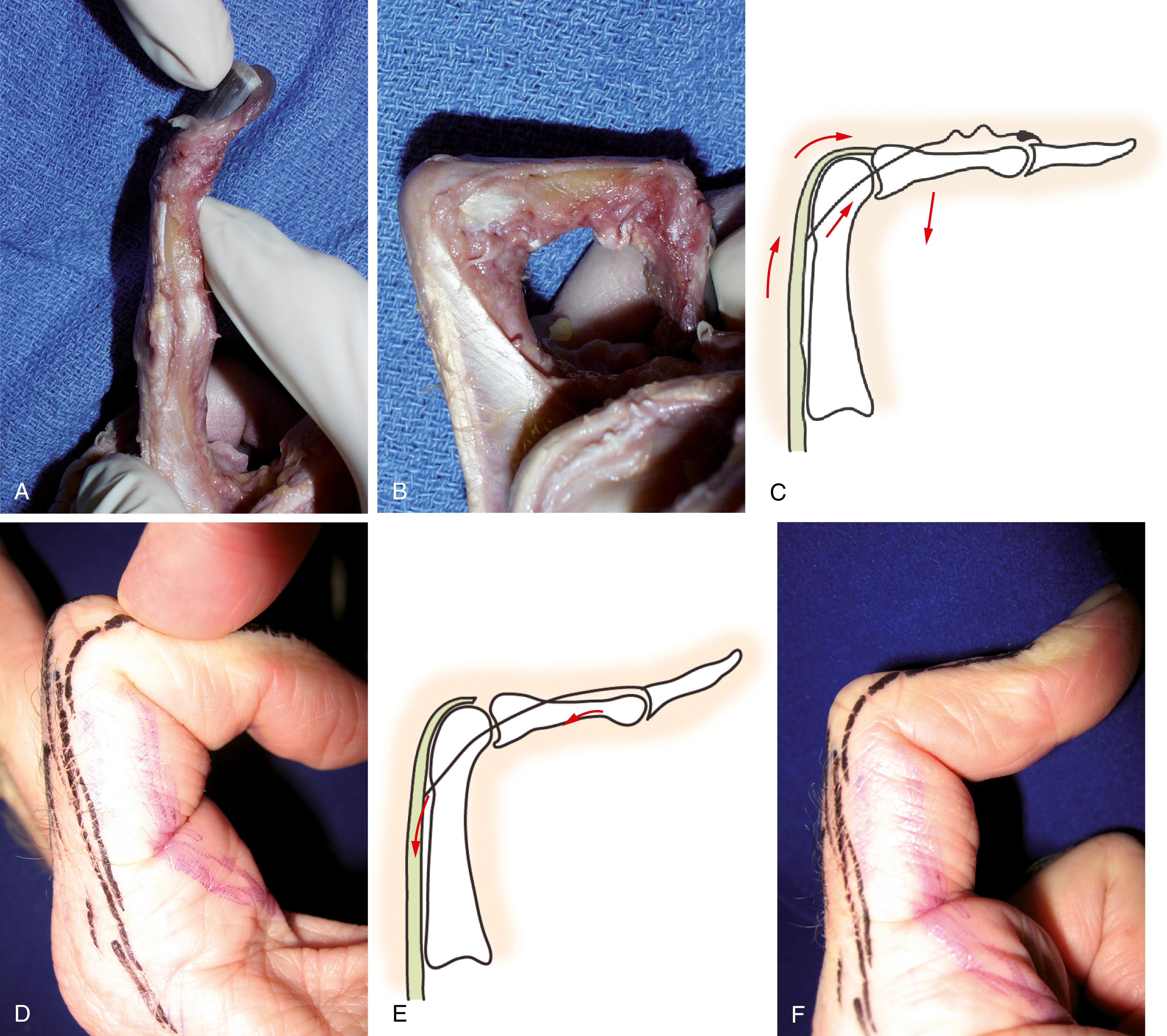
When the central slip is injured or incompetent, it is possible to generate extensor force at the DIP joint with maximal passive PIP joint flexion, which is the basis of the Elson test for detecting acute central slip rupture. As described by Elson, the examiner passively flexes the PIP joint to 90 degrees over a tabletop and asks the patient to attempt active extension of the PIP joint while the examiner resists PIP joint extension. When acute rupture of the central slip occurs, no extension power is felt at the PIP joint but significant extension power, or hyperextension, is produced at the DIP joint. This test has been found to be the most sensitive physical examination test to detect acute central slip rupture.
In practice, I find that the Elson test is best performed under a digital block to eliminate any pain that may arise from a concomitant injury to the PIP joint. The hand is supinated, and the examiner passively maximally flexes the injured PIP joint with one hand and then asks the patient to attempt PIP joint extension as the examiner assesses extension force at the DIP joint by gently flexing the DIP joint with the other hand. If the examiner feels DIP joint extension with greater force than the adjacent or contralateral noninjured digit held in the same position, the central slip is incompetent. Boyes described another test for central slip integrity in 1970, in which the PIP joint is held in extension while the examiner assesses resistance to passive DIP joint flexion. This test is not helpful in acute situations, and it becomes positive only as a boutonnière deformity develops because of chronic retraction of the lateral bands.
Landsmeer described the oblique retinacular ligament (ORL) (also termed the Landsmeer ligament ) as originating from the flexor sheath at the volar aspect of the PIP joint and inserting dorsally into the terminal tendon (see Fig. 5.5 ). The ORL theoretically tightens with extension of the PIP joint and extends the DIP joint during PIP joint extension. The ORL has been postulated to be the reason why DIP extension is preserved following sectioning of the terminal extensor tendon for a boutonnière deformity. An alternative explanation for this phenomenon is that the contracted DIP joint collateral ligaments could account for “spring back” of the DIP joint to neutral following terminal tendon sectioning for a hyperextended DIP deformity. The existence and function of the ORL have been the subject of debate. Shrewsbury and Johnson showed that it is present less than 50% of the time except on the ulnar side of the ring finger, where it is found more than 90% of the time. Ueba and colleagues found the ORL present in 38 of 40 cadaver fingers in an anatomic and biomechanical study; the ORL contributed up to 30% of passive resistance to DIP joint flexion, with a maximum at 30 degrees of PIP joint flexion. Shrewsbury and Johnson believed the presence of a functioning terminal tendon alone was sufficient to account for full extension of the DIP joint, and that the ORL was of no practical functional importance. Excision of the ORL has not been shown to cause an extensor deficit at the DIP joint, though preservation of the ORL, if present, is prudent during surgical exposures.
Regardless of its presence or absence, the concept of the ORL is useful in surgically creating a passive tendon “checkrein” to enable simultaneous DIP and PIP joint extension in the setting of a chronic mallet finger.
Boyes determined that the amplitude of tendon excursion for the wrist extensors is 3.3 cm and the amplitude of tendon excursion for the finger extensors and EPL is 5 cm; however, most of this excursion occurs over the forearm, wrist, and dorsal hand. The amplitude of tendon excursion over the dorsum of the finger is extremely small; this explains why small tendon gaps, overtightening of tendon repairs, or small amounts of bony shortening or angulation can lead to dramatic extensor lags or restriction of flexion at the PIP and DIP joints. Vahey and associates found that an experimental 12-degree PIP joint extensor lag was produced with every 1 mm of tendon lengthening over the proximal phalanx. Schweitzer and Rayan showed that 1 mm of terminal tendon lengthening resulted in a 25-degree DIP joint extensor lag and that 1 mm of terminal tendon shortening severely restricted DIP joint flexion.
Over the dorsum of the hand, it has been shown experimentally that relative lengthening of the extensor tendon by 2 mm produces an extensor lag of approximately 7 degrees at the MP joint. Because most MP joints had a “reserve” of hyperextension ability of about 35 degrees, however, 5 to 6 mm of relative extensor tendon lengthening in this zone may not produce a clinically relevant lack of extension.
The classification of extensor tendon injuries proposed by Kleinert and Verdan ended at zone 8 (the forearm). Doyle added a ninth zone for the muscular area of the extensor mechanism at the middle and proximal forearm. The classification is easy to recall if one remembers that the joints are odd numbered; from distal to proximal, the DIP joint is zone 1, PIP joint is zone 3, and so forth. The thumb IP joint is zone 1, and the MP joint is zone 3 ( Fig. 5.9 ).

There are few published studies on the strength of various suture techniques for extensor tendon injuries compared with the plethora of studies concerning flexor tendon repair techniques. One problem concerns the variability in the thickness of the extensor tendon as it changes from proximal to distal. Proximally, at the forearm and wrist level, the tendons are thicker and more capable of holding core sutures, and at the finger level, the tendons become broader but quite thin, and are incapable of holding standard core sutures. Doyle measured the thickness of the extensor mechanism in the fingers to be within a range of 1.75 mm in zone 6 (dorsal hand) to 0.65 mm at zone 1. A similar range was found at the thumb level.
In 1992, Newport and Williams found the Kleinert modification of the Bunnell repair to be the strongest technique in a cadaver study of zone 6 extensor tendon repairs performed with 4-0 polypropylene (Prolene) suture material. In 1995, Newport and coworkers reported that the Kleinert-modified Bunnell technique and the modified Kessler technique were the strongest techniques for zone 4 injuries and were suitable for dynamic or active range of motion under controlled conditions and in short arcs.
In 1997, Howard and colleagues compared the MGH, modified Bunnell, and modified Krackow-Thomas repairs in cadaveric zone 6 extensor tendon lacerations and found the MGH technique to be superior. In a 2005 study of zone 4 extensor tendon repairs with 4-0 nonabsorbable, braided polyester (Ticron) suture, Woo and coworkers found the modified Becker technique to be the strongest repair, with a significantly greater resistance to a 1- and 2-mm gap and the greatest ultimate strength. Lee and colleagues compared the augmented Becker technique, the modified Bunnell technique, and a new, running interlocking horizontal mattress technique (RIHM) and found the newer technique to be stiffer, to produce less shortening, and to be faster to accomplish than the other techniques, without a significant difference in the ultimate load to failure. This newer technique does not require the placement of core sutures and was found to have good to excellent clinical results in a study of zones 4 and 5 extensor tendon lacerations ( Fig. 5.10 ).
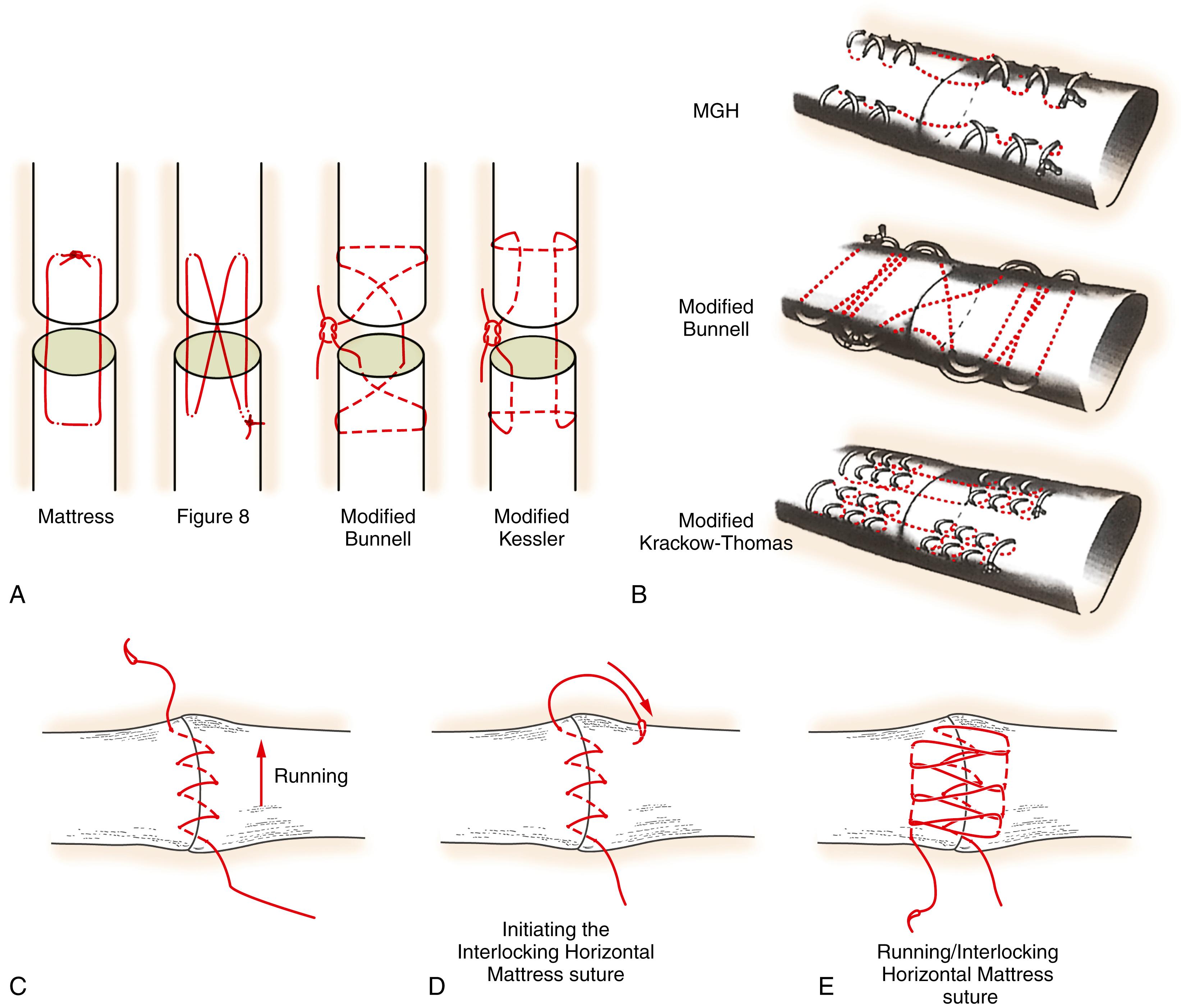
Doyle proposed the following techniques for extensor tendon repair:
Zone 1 (DIP joint): Running suture incorporating skin and tendon.
Zone 2 (middle phalanx): Running 5-0 stitch near cut edge of tendon, completed with a “basket-weave” or “Chinese finger trap” type of cross-stitch on the dorsal surface of the tendon ( Fig. 5.11 ).
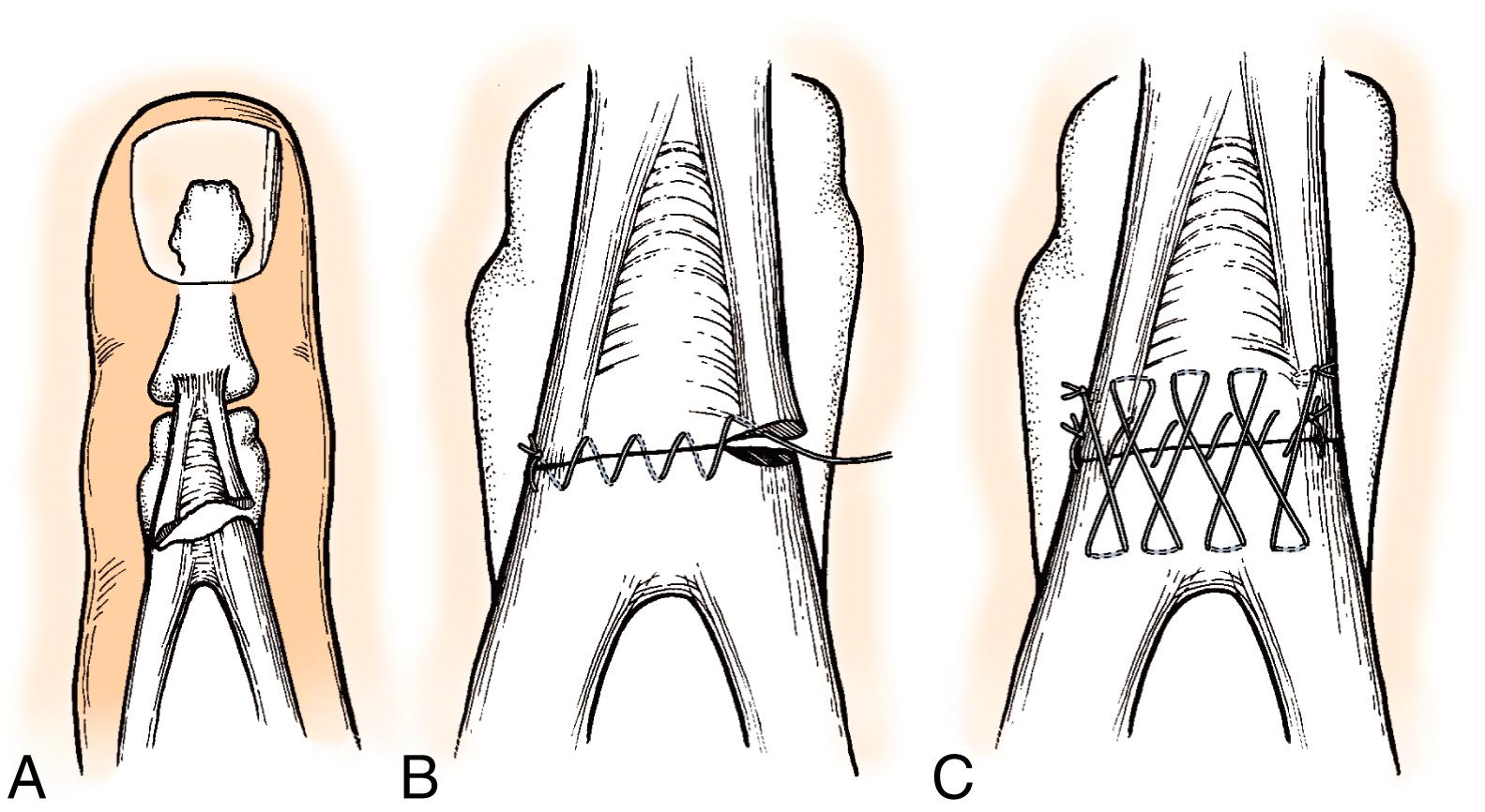
Zones 3 through 5 in fingers and zones 2 and 3 in thumb: Modified Kessler suture of 4-0 synthetic material in the thickest portion of the tendon. A 5-0 cross-stitch tied to itself at the beginning and end is run on the dorsal surface of the tendon ( Figs. 5.12, 5.13, and 5.14 ).
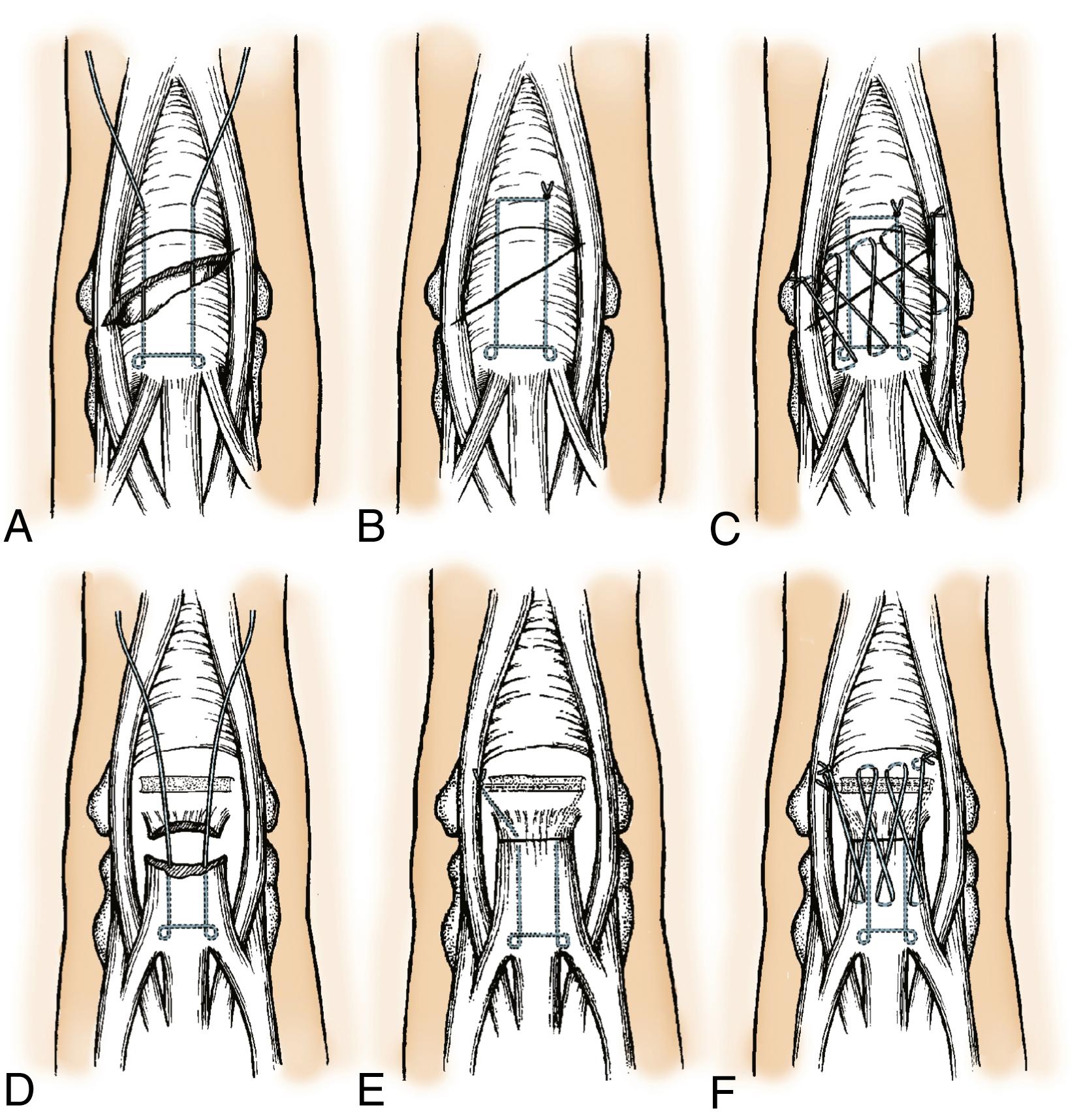
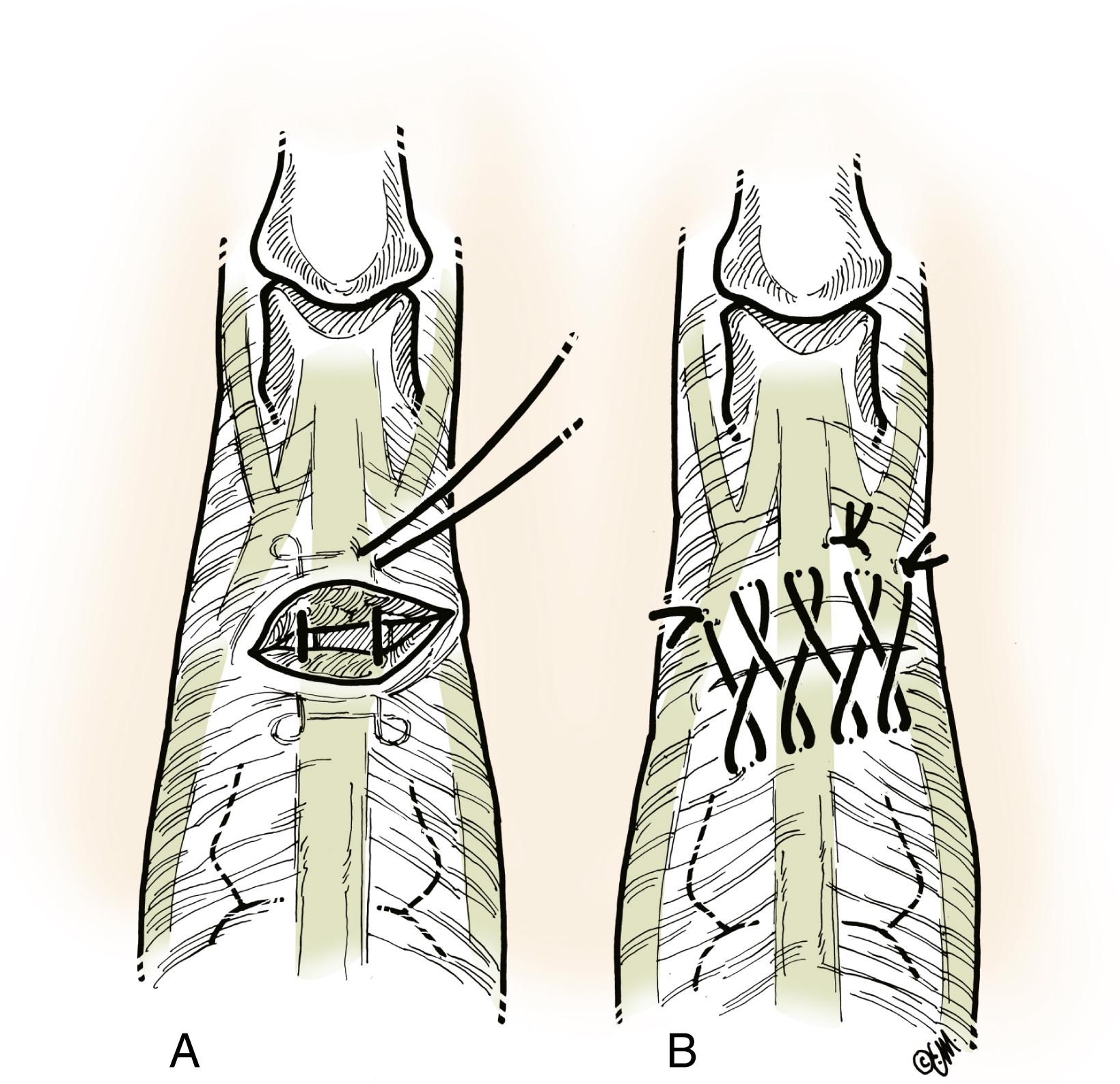
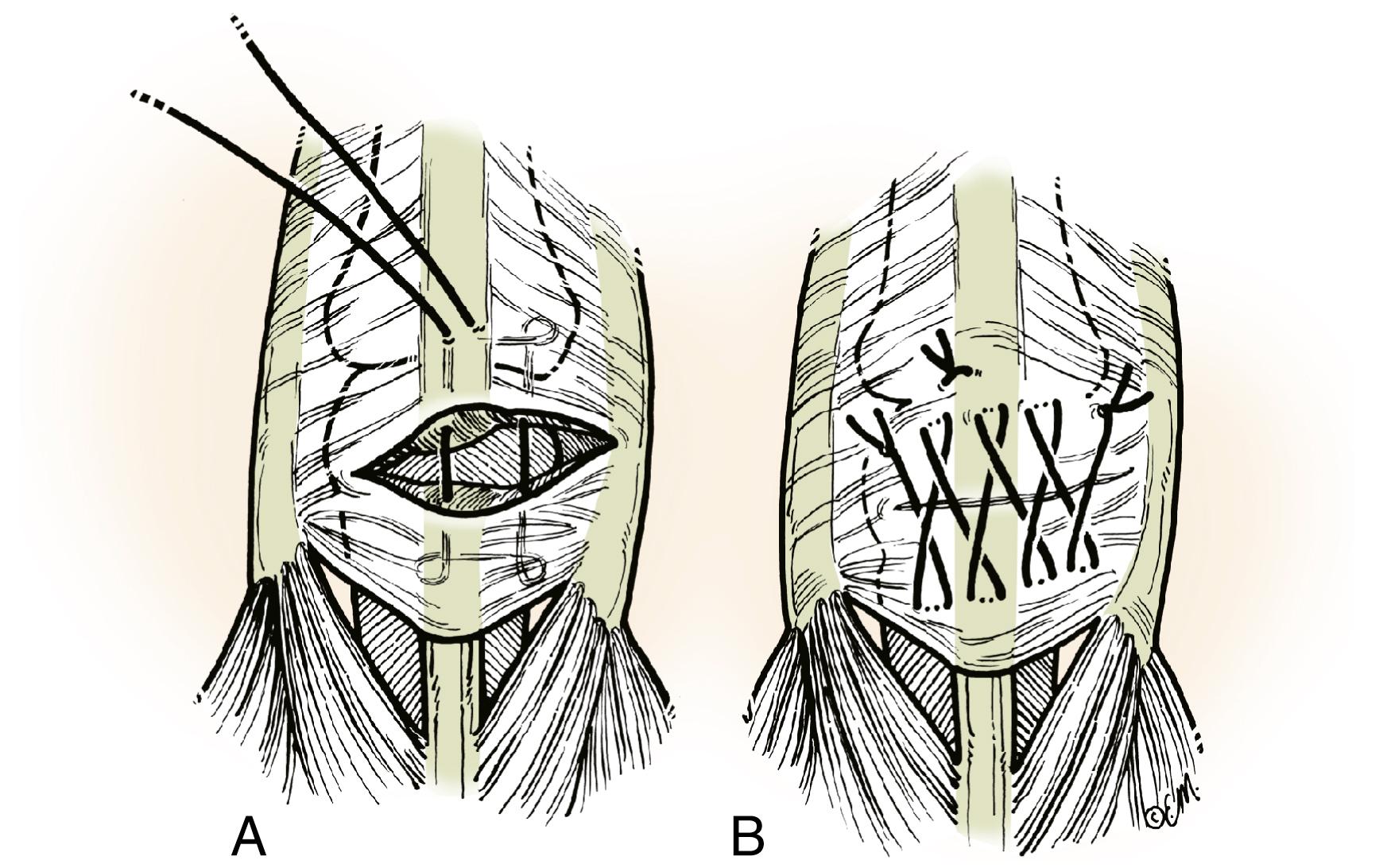
Zones 6 and 7: Same as for zones 3 through 5, except the cross-stitch is run around the entire circumference of the tendon, if feasible.
I agree with Doyle’s recommendations except that I usually use two narrow modified Kessler core suture repairs for zones 3 through 5 complete tendon lacerations, on either side of the tendon, to avoid “bunching up” of the tendon. For zone 1 injuries, I do a running suture of 5-0 polypropylene supplemented by a transarticular Kirschner wire in full extension for 6 weeks, instead of a “roll” suture incorporating skin and tendon; sometimes I will use several interrupted and buried figure-of-eight 5-0 polypropylene sutures to anatomically reapproximate the tendon in zones 1 to 4, if the tendon laceration is jagged.
The traditional postoperative program for extensor tendon repairs in zones 1 and 2 is 6 weeks of DIP joint immobilization in neutral extension with either splint or Kirschner wire fixation, and this generally remains the preferred regimen. Zones 3 through 5 repairs have historically been protected with the wrist in 40 degrees of extension, slight flexion at the MP joint, and extension at the PIP joints for 4 weeks. Zones 6 and 7 repairs have usually been managed with similar wrist and MP joint extension, allowing full active motion at the IP joints for 4 weeks. As in the rehabilitation of flexor tendon injuries, the main concern after repair is to maintain the integrity of the repair while limiting adhesion formation. The concept of early protected range of motion has been investigated for extensor tendon injuries, as it has been for flexor tendon injuries.
The ideal candidate for accelerated range-of-motion therapy is a motivated patient with a complex injury involving more than one structure (e.g., tendon, bone, nerve). The concept involves moving joints through a controlled arc of motion in order to promote extensor tendon gliding of 3 to 5 mm and limit adhesion formation. Evans and Burkhalter found that 30 degrees of MP joint flexion created 5 mm of EDC glide in zones 5 through 7. The EPL glides approximately 5 mm at the Lister tubercle with 60 degrees of thumb IP joint flexion. The Evans and Burkhalter method of postoperative rehabilitation for extensor tendon repair in zones 5 through 7 starts with dynamic splinting 3 days postoperatively to allow MP joint flexion to about 30 degrees, keeping the wrist in 45 degrees of extension. Dynamic splinting involves passive joint extension with a dynamic outrigger device, with flexion limited by the confines of the palmar splint ( Fig. 5.15 ). Controlled active mobilization involves active joint extension, limiting joint flexion with a palmar splint. Short arc motion protocol involves passive extension splinting with intermittent, splint-assisted passive flexion and active extension. The concept of using a relative motion splint (RMS) rehabilitation protocol was popularized by Merritt, and a recent review suggested that an RMS protocol could allow an earlier return to work than a controlled active motion protocol. The RMS protocol for zones 4 to 7 involves placing the repaired tendon in 20 degrees greater extension than the adjacent digits for 6 weeks, preserving full IP motion; the wrist is placed in a separate splint at 20 degrees of extension for the first 3 weeks. The concept of the RMS is similar to that used for sagittal band rupture ( Fig. 5.16 ) Table 5.1 summarizes studies done on various postoperative splinting protocols.
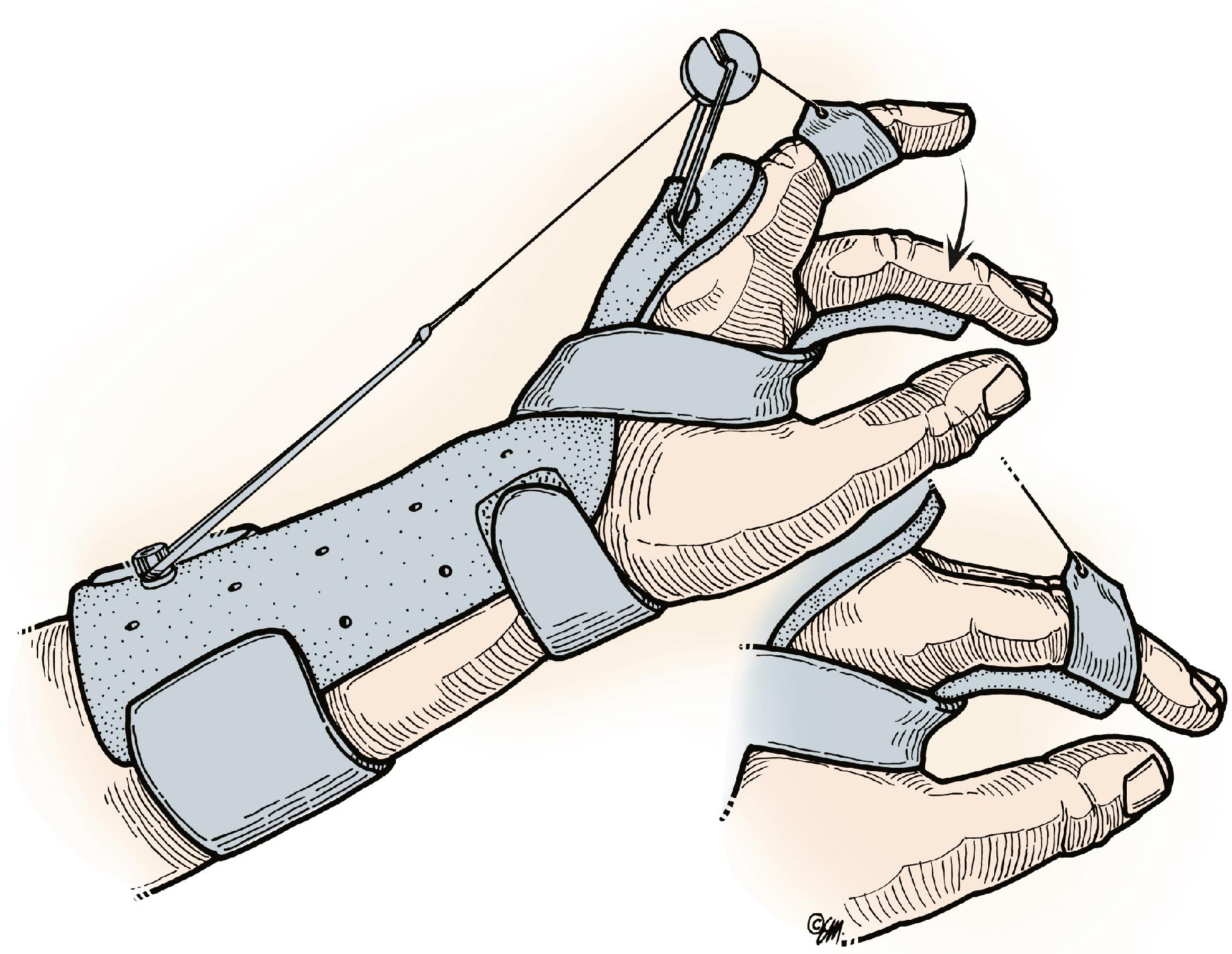
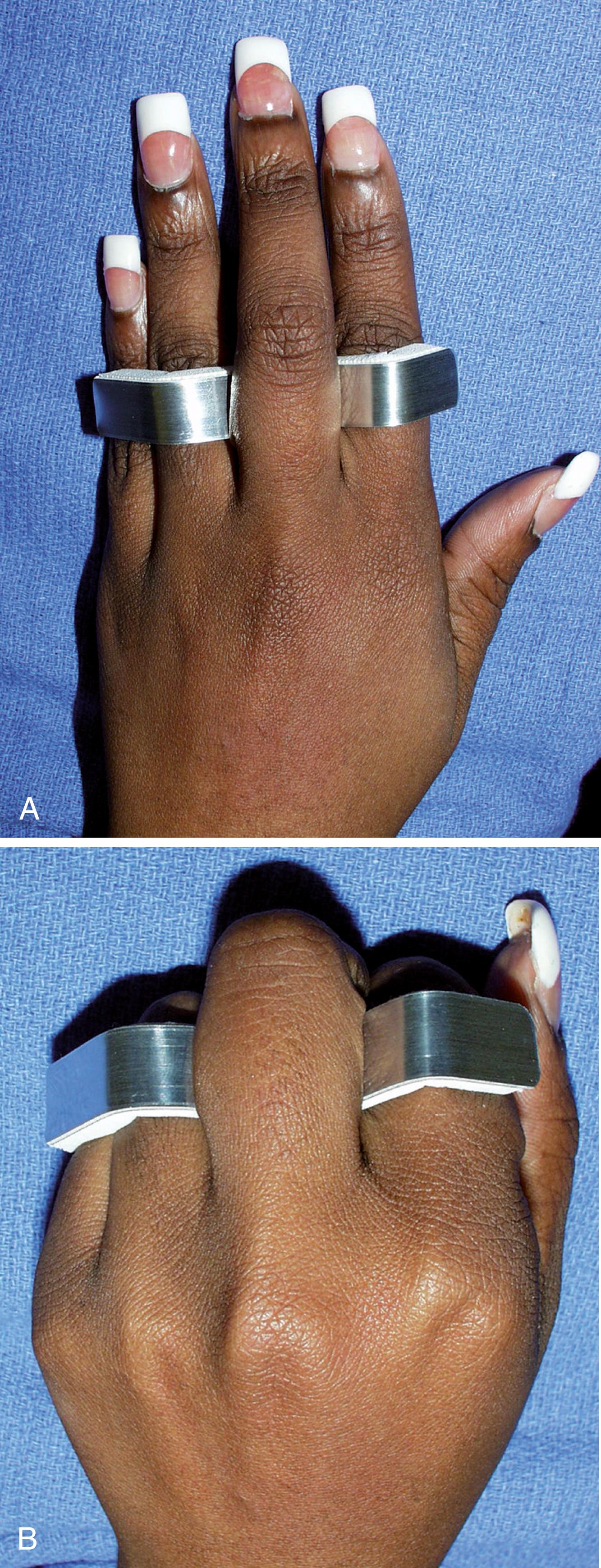
| Study | Year | Zones of Injury | Comparison | Results |
|---|---|---|---|---|
| Browne and Ribik | 1989 | Zones 4–7 | Dynamic splinting only | Full flexion in all. No tendon ruptures. |
| Chow et al. | 1989 | Zones 4–7 | Static vs dynamic splinting | Dynamic splinting better than static |
| Hung et al. | 1990 | Zones 2–5; prospective study | Dynamic splinting only | Poor results distal to MP joint |
| Saldana et al. | 1991 | Zone 3 only | Dynamic splinting only | Most good or excellent. One mild boutonnière deformity. |
| Evans | 1994 | Zone 3 | Static extension splinting vs early active short arc motion | Short arc motion is better |
| Sylaidis et al. | 1997 | Zones 4–7 | CAM; not dynamic splinting | Excellent results in 22 of 24 cases |
| Purcell et al. | 2000 | All zones | Static splinting only | 76% excellent, 24% good results |
| Khandwala et al. | 2000 | Zones 5–6 | Dynamic splinting vs CAM | No difference between groups. Prefer CAM as simpler and less expensive. |
| Chester et al. | 2002 | Zones 4–8; prospective randomized study | Dynamic splinting vs CAM | Dynamic splinting better at 4 weeks but no differences between groups at 3 months |
| Brüner et al. | 2003 | Zones 5–7 | Retrospective evaluation of dynamic splinting alone | Excellent/good results in 94% |
| Russell et al. | 2003 | Zones 5–8 | Dynamic splinting vs static splinting | Prefer static splinting because results similar |
| Mowlavi et al. | 2005 | Zones 5–6; prospective randomized study | Dynamic vs static splinting | Dynamic better at 4, 6, and 8 weeks but not at 6 months |
| Howell et al. | 2005 | Zones 4–7 | Relative motion splint only (ICAM splint) | Majority of patients had excellent results |
| Bulstrode et al. | 2005 | Zones 5–6; prospective comparative trial | Static splinting of MP and IP joints vs static splinting allowing IP motion only versus Norwich regimen | Motion in static group worse at 4 weeks but equal at 12 weeks |
| Kitis et al. | 2012 | Zones 5–7; prospective randomized trial | Dynamic vs static splinting | Dynamic better at 12 weeks and 6 months |
| Neuhaus et al. | 2012 | Zone 4–5 | Dynamic splinting only | All patients except one had good or excellent results |
| Patil and Koul | 2012 | Zone 5–8; prospective randomized trial | Static vs early active motion | Active better at 12 weeks but equal at 6 months |
| Collocott et al. | 2018 | Zones 5 and 6 randomized clinical trial | Relative motion splint vs controlled active motion | Earlier recovery of motion and outcomes at 4 but not 8 weeks with relative motion splint |
In 1942, Miller suggested criteria for assessing extensor tendon repair outcomes, which were later endorsed by Newport and associates ( Table 5.2 ). This rating system takes into account extension lag and loss of flexion secondary to extensor adhesions and stiffness in terms of total active motion. In 1990, Newport and colleagues reported on the long-term results of extensor tendon repair treated with static splinting. Of patients without associated injury, 64% achieved good or excellent results, whereas only 45% of patients with associated injuries achieved good or excellent results. More fingers lost the ability to flex fully than lost the ability to extend. Injuries in zones 1 through 4 had worse outcomes than injuries in the more proximal zones. Fair or poor results were found in 7 of 12 zone 1 injuries, 6 of 6 zone 2 injuries, 10 of 14 zone 3 injuries, and 4 of 7 zone 4 injuries. These injury zones were associated with total extensor lags of the PIP and DIP joints of 11 to 45 degrees or more, and loss of flexion of 21 to 45 degrees or more. Zones 5 through 7 usually regained approximately 80% or more of normal motion. In a prospective randomized trial of dynamic versus static splinting for uncomplicated zones 5 and 6 lacerations, Mowlavi and coworkers found total active motion of 250 degrees for both groups at 6-month follow-up, with grip strength of 80% of normal in the dynamic group and 73% of normal in the static group. A systematic review of the literature in 2012 noted that both static and early motion protocols resulted in favorable results, but neither technique could be shown to be superior owing to variability in outcome measure reporting.
| Result | Total Extension Lag (degrees) | Total Flexion Loss (degrees) |
|---|---|---|
| Excellent | 0 | 0 |
| Good | ≤10 | ≤20 |
| Fair | 11–45 | 21–45 |
| Poor | ≥45 | ≥45 |
I employ dynamic splinting and controlled active motion for extensor tendon injuries in zones 4 through 7 in compliant patients. An RMS is an alternative if one to two fingers are involved, but it becomes technically difficult if more than two fingers are involved since then it is hard to provide “relative” motion. There is no level I evidence that accelerated rehabilitation confers any long-term advantage in outcome over static splinting, though it may lead to earlier recovery of motion and function.
Adhesions are the most frequent complication of extensor tendon repair and can cause an extension lag and loss of flexion. An extensor tenolysis may be considered if, after 6 months, progress is considered to be unsatisfactory by the patient. Tenolysis of the extensor mechanism over the hand and finger may require concomitant joint releases and flexor tenolysis, either simultaneously or in a staged fashion. In the ideal situation, full passive motion should be present before tenolysis because this implies that there are no secondary capsular or ligamentous contractures. Lack of full passive motion after an appropriate course of therapy is not a contraindication to surgery, but the patient should be aware of the diminished expectations when joint release and mobilization are necessary simultaneously. Creighton and Steichen reported the results of tenolysis after fracture and found only a 31% improvement in total active motion overall, 50% improvement in extensor lag if only a tenolysis was required, and 21% improvement in total active motion if a dorsal capsulotomy was required, with no improvement of the active extensor lag.
“Bunching up” the flat extensor tendon over the phalanges with one large core suture should be avoided.
Repairs in zones 1 through 3 are not usually amenable to early motion protocols.
Dynamic splinting may be used for injuries proximal to the PIP joints but may not produce better long-term outcomes than static or early active motion rehabilitation.
Loss of digital flexion may be greater than residual loss of extension.
Repairs in zones 1 through 4 typically have worse motion than more proximal injuries.
A 45-year-old woman is kicked by a horse. Her left small finger DIP joint is subluxated volarly and deviated radially ( eFig. 5.1A and B ).
The injury is not passively correctable. There is a “springy” feel when full extension of the joint is attempted.
Surgical exploration includes:
Ulnar collateral ligament of DIP joint torn and flipped into joint
Extensor mechanism torn 90% from ulnar to radial ( eFig. 5.2 )
Treatment:
Interposed ligament extracted and repaired
DIP joint pinned in neutral
Extensor mechanism repaired with interrupted 5-0 polypropylene sutures ( eFig. 5.3 )
Pins removed 6 weeks postoperatively
Outcome at 1 year postoperatively:
10-degree extensor lag
Full flexion
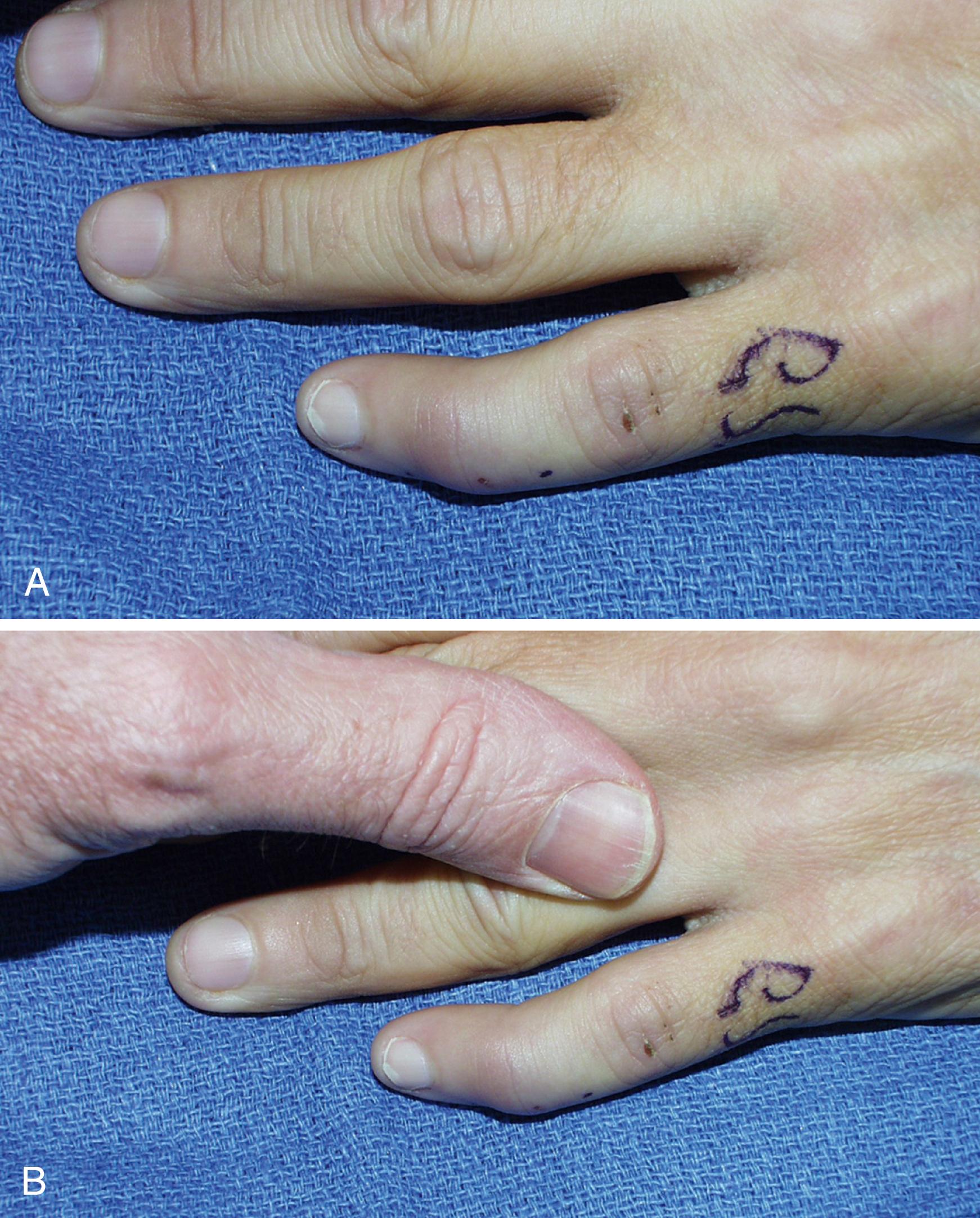
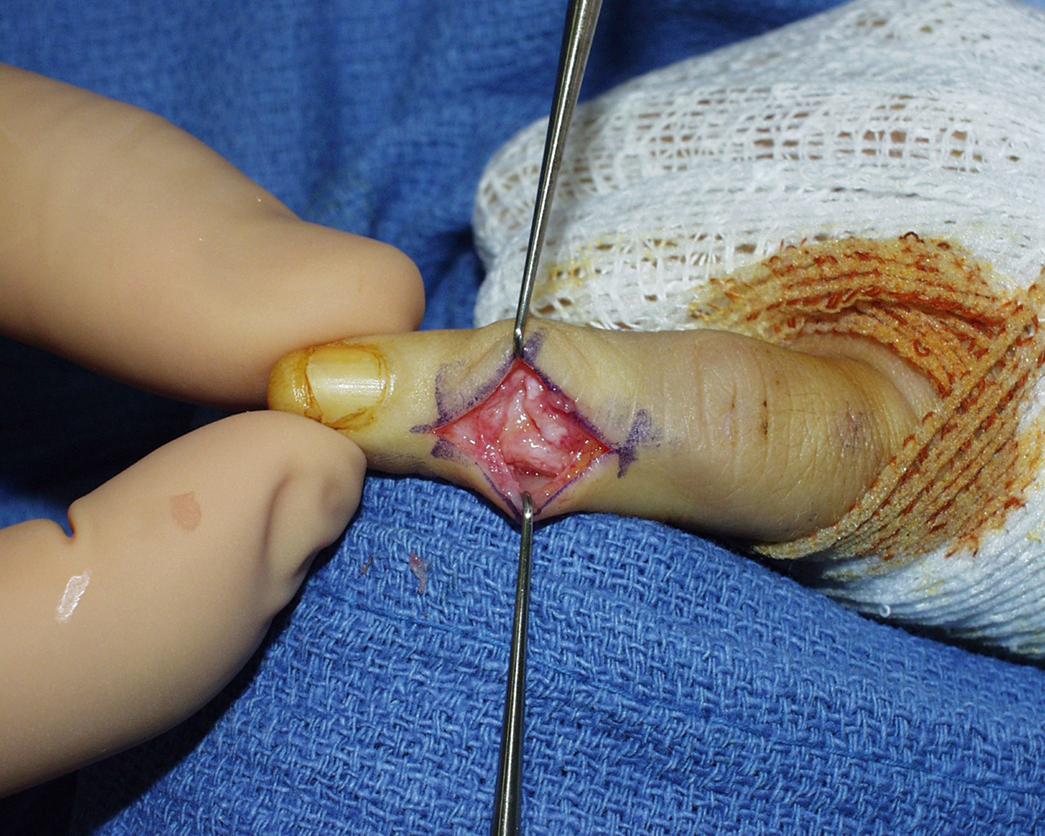
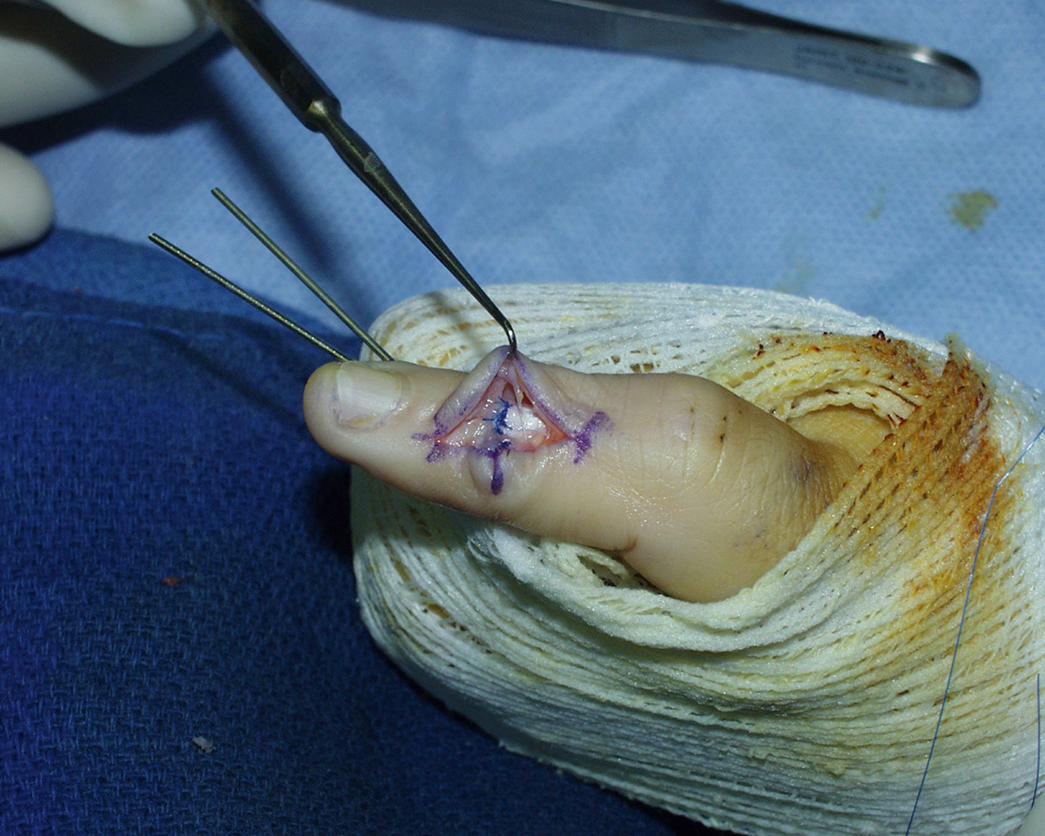
Mallet finger injury is characterized by discontinuity of the terminal extensor tendon resulting in an extensor lag at the DIP joint with or without compensatory hyperextension at the PIP joint (swan neck deformity) . The injury has also been termed drop finger or baseball finger. Mallet fingers are classically described as “soft tissue” (tendon rupture) or “bony” (avulsed fragment of bone). For a seemingly simple injury, a lengthy, tedious treatment course is often required to obtain a satisfactory result. Poor outcomes are not unusual and can be a considerable source of frustration for the patient and the surgeon.
Mallet finger most commonly involves a closed rupture of the terminal tendon with or without associated fracture of the distal phalanx. The deformity is often unnoticed at the moment of injury. Snagging the extending finger on a pants cuff, a bedsheet, or other object that suddenly flexes the extending DIP joint is a frequent cause. Less commonly, a forceful hyperextension injury of the DIP joint may result in a large fracture of the base of the distal phalanx involving one-third or more of the articular surface. Elderly patients with osteoarthritis of the DIP joint may have “mallet” deformities that are not related to trauma, and individuals with hyperlax joints may have multiple pseudomallet swan neck postures that are unrelated to trauma. Open mallet injuries are uncommon.
The most frequently involved digits are the small, ring, and middle fingers of the dominant hand, with a male predominance. Tendinous mallet fingers have been reported to occur from age 11 onward. In skeletally immature individuals, a transepiphyseal plate fracture may be seen. According to Jones and Peterson, who noted 20 mallet fingers in 7 family members, there may be a familial predisposition to mallet fingers.
Become a Clinical Tree membership for Full access and enjoy Unlimited articles
If you are a member. Log in here